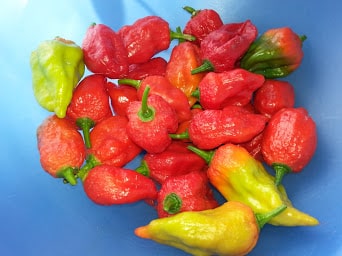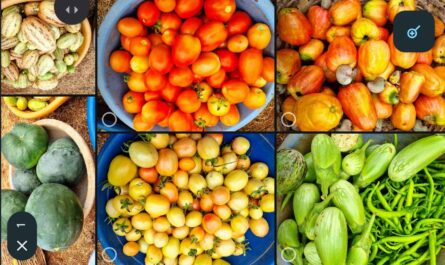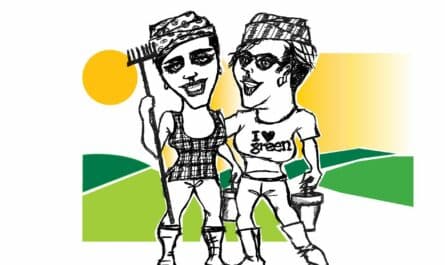A new day, a new (mis) adventure!
It sounds like a cliché when I say there is never a dull day at the Farm. From the day we set eyes on this land, we have hurtled from recalcitrant sellers and bullying fiends to high voltage village meetings and midnight boring for water! We’ve also enjoyed an abundant harvest, grown gorgeous oyster mushrooms, and have the satisfaction of knowing we’ve planted over 500 trees.
Things had been ticking along nicely after the government survey, and we were finally getting our boundaries fenced. As I mentioned in an earlier blog post, the survey unearthed and identified almost an acre and a half of land more than we were using!
So, while our farm consultant, S, got busy fencing our land, our full-time employees, the Imp and his wife, planted tomatoes, chilli, brinjal, okra, sweet potato, and other vegetables.
Over a few weeks, we harvested loads of fast-growing spinach, fenugreek (methi), coriander and bucketloads of marigold while we waited patiently for the rest of the vegetables to grow.
Late one night, Farm Manager M called in a state of high agitation to say, “Ghure ni bhaji khalli!” (I must admit, I had no idea who or what a Ghure was, but after going through the list of animals – goat, pig, cow – I figured he meant cattle). It turns out there was a gap that hadn’t yet been fenced, and late at night, a marauding horde of cattle stormed in and ate everything in sight. Oddly, they didn’t touch our tomato plants as the smell from the leaves repels them! Learn a new thing every day!
Our farm visit the next day was a sombre affair as we took in our trampled and destroyed vegetable patch and, more distressingly, our ravaged banana, papaya and drumstick trees. More upset than us was the Imp, who was near tears as he had put his blood and sweat into the plants. He swore he would stay awake and guard every night until the fencing was complete.
So it was that while the Bears were busy bringing down the stock market, we had a Bull Run on our Farm.
To compensate for the loss, we decided to plant another 100 banana trees and distracted the woebegone Imp by walking around the land to discuss where these trees were to be planted. We also looked at our unharmed tomato patch and were happy to see we would soon get a few dozen tomatoes. Practical matters took over our discussion, and we left feeling a wee bit better than when we had arrived.
A few days later, Farm Manager, M, called to say a thief (well, a ‘drunk villager’ were the words he used) had crept into our tomato patch and stolen all the tomatoes! So, that was that! No vegetables at all to show for all the hard work, the thousands of seeds and the hundreds of feet of drip irrigation.
Once the fencing was finally complete, we installed tall, formidable gates, which we locked with the sturdiest locks I could buy.
We had no time to mourn the Bull Run as we were soon busy planning our rice cultivation.
We demarcated a little over 1.5 acres of level land that would collect rainwater (the Farm is at a slight height on the Sahyadri mountain range) and decided what rice and millet varieties we would plant. We contracted a man from the neighbouring village to organize the rice plantation and discussed whether he would do the work for a share of the crop or a fee. It was finally decided that he would charge us for the labour. Then we discussed the merits and demerits of tractor versus cattle-drawn plough. The plough won. The primary reason for this is we have planted so many trees; there is no way to get a tractor to reach all the paddy fields without breaking the fence we had just completed or knocking down the trees!. Mr Paddy Contractor (Mr PC) also tried to persuade us to use chemicals and fertilizers by saying our yield would be very small if we insisted on organic farming. But we were firm; low yield is a price we will willingly pay for chemical-free, organic produce.
In short order, Mr PC burnt small patches of land in each paddy and millet field to prepare them for the “nursery”. This burning is done to remove residual plants and help the plants about to come up. These are often called “prescribed burns” because they are used to improve the health of the field. In the meanwhile, the Imp built bundhs or mud channels to retain the rainwater.
And then, we waited for the first rain. And waited. And waited some more.
While we waited, I had a conversation that will embarrass me for the rest of my life! A few months ago, I was in Assam with my fabulous bunch of naturalist friends and decided to use the opportunity to procure black rice seeds for the Farm. One contact led to another, and I finally had a name and number of a person who would send me the seeds soon after I returned to Mumbai.
On returning home, I called the Seedman, and I am reproducing the conversation ad verbatim:
Seedman- bhen eez your cantibaishan
Me – anytime you say
Seedman – how I can say bhen eez your cantibaishan
Me – oook…send me your bank details
Seedman (apocalyptic) – bhay u bhaunt my bhank details
Me – uh..for contribution
Seedman (shouting) – bhen you bhrebhare land, bhen you sow seed??
Penny drops …kaaching
Me (shamefaced) – my cultivation starts in June
Awkward conversation done, I soon received the black rice seeds. And once farm manager M bought the kolam seeds (type of short-grained local rice) and our Mr PC procured a small amount of nachni seeds (ragi or foxtail millet), we were all set.
The first rains finally drenched the land, and inhaling the unique fragrance of petrichor, we watched as Mr PC ploughed the prepared patches and sowed the seeds.
Then, it was another long wait as we watched the seeds germinate, grow taller and sway in the breeze. It really was a wonderful sight.
After a slight break in the rains, the skies opened up, and we had ten days of torrential rain on the Farm. Truly manna from heaven. The seeds grew to about a foot high, and the paddy fields got wet and slushy. When the day finally arrived to transplant the rice, Bandra Rose, Mr Stonethrower, and I piled into the car at 6 am and set off for the farm.
En route, we stopped at our favourite Kolad – Sangam Sweets store at a three-road junction, Sangam. Get it? – and bought boxes of assorted Indian sweets for the community lunch that had been organised at the Farm.
The sowing was underway by the time we arrived. Mr PC had brought a crew of nine people to work with him – five women and four men. He also had two ploughs and four benign bulls. Along with our local team of four and the three of us, we were a labour force of 16 people.
Our first job was to harvest the seedlings and tie them in small bundles ready for transplanting. This is genuinely back-breaking work. You must sit on your haunches and pluck each seedling by hand. No implements, no machines, nothing. Just rows of people pulling out each germinated seed. The crew worked efficiently and cheerfully, exhorting us to join them. They mocked our designer gumboots and said they were useless as they would sink in the sticky mud and shin-deep water.
Meanwhile, Mr PC and his pal drove the cattle ploughs round and round the fields turning the sticky soil and channelling the water to flood the areas. It was hard work. It was repetitive work. And it was exhilarating work.
We soon shed our gumboots and got to work. The ladies were good-natured and indulgent and patiently showed us how to sow. They steadied us when we stumbled, helped when we got our feet stuck in the mud and directed us to the wetter patches that were easier to sow. We worked alongside the crew for the entire day, and once the ice was broken, we joined in the camaraderie and fun. Songs were sung, harvest yields calculated, and the benefits of working after a few tipples discussed; but not for one moment did their hands stop working. Plant, plant, take a step back, and start on the next row. Plant, plant, take a step back, start on the next row. On and on and on.
While we were nowhere as precise or quick as them, I don’t believe we embarrassed ourselves. Ten minutes into it, all three of us were working unsupervised. We joked with the crew, saying since we were managing so well, we probably wouldn’t need any help next year!
Mr Stonethrower was encouraged to try his hand at the nangar (cattle-drawn plough) but gave up quickly as the bulls refused to do his bidding! No running with the bulls for him!
By 1 pm, we had finished sowing one of the five fields and declared a lunch break.
The lunch for all of us had been prepared by Mrs PC. One of the women went off to get the ladies’ vegetarian lunch. We were to get the non-vegetarian fare that the men would eat.
Lunch was eaten in the large shed we had constructed to store our hay, drip irrigation pipes and other sundries. It has a sturdy roof of Mangalore tiles to keep out the sun and rain. Chatais or mats were spread, and we all sat on the floor to eat. The menu was:
Rice Bhakri [flatbreads made with rice flour]
Chicken curry
Chicken Rassa [a thin spicy stock in which the Chicken had been boiled]
Rice
With a selection of condiments – limes, sliced onion and green chilli plucked from 5 meters away.
The ladies took charge of serving everyone. We three city folks insisted on child portions as the volume of rice served to the men was enormous. On each plate was a handful of rice, half a Bhakri, Chicken Curry and a bowl of Chicken Rassa. To our considerable surprise, the curry and Rassa were steaming hot. Mrs PC had done something quite ingenious. The two upright containers of Curry and Rassa had been shoved deep into the large vat of rice, effectively insulating the liquids while at the same time keeping the rice warm. Brilliant. The food was spicy and tasty, cooked with heart and as the cliché goes, love – love for the food, not love for us!
Once the men were thru, the ladies sat down to eat. I must say the Pea and Potato bhaji they ate looked good. Then, the Mithai was distributed.
By any standards, this was a good meal. Although we Bandra Girls [and boy] cannot eat as much as any of them or handle that volume of spice at every meal, we thoroughly enjoyed ourselves.
Then, no rest for the wicked. No time to sleep off this heavy lunch. Back to work, and all systems go.
An amazing day. A fulfilling and satisfying experience. One that we will repeat in years to come.
If the monsoon stays good, we have 90 days before we harvest the kolam rice and 150 days for the black rice.
We keep our fingers crossed for a proper Bull Run of rice and millets.




Loved the Running with the Bulls post. Your descriptions are so visual, I feel like I’m right there inspecting the wreckage after the bull attack or sitting cross legged and tucking into the community rice and chicken curry . Can’t wait for the sequel. PS: Missing the picture of Mr Big Bull on the plough …
Thanks P, missed you ladies lots and lots!
Superb piece. Vivid and descriptive. Enjoying walking the journey with you through these blogs. Can’t wait to taste the rice 😋